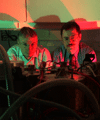August
Sir Bobby’s legacy purchases first-in-Europe equipment to fight cancer

Experts provide a preview of the newly-created unit which will help Newcastle scientists fight cancer thanks to the biggest-ever donation from the Sir Bobby Robson Foundation.
Newcastle University and the Sir Bobby Robson Foundation have purchased an Advanced Biomarker Technology Biomarker Generator, an ultra-compact cyclotron, the first ever in Europe and only the second in the world of its type. It will help with the diagnosis and treatment of cancer and others serious diseases in the Sir Bobby Robson Foundation PET Tracer Production Unit.
The Biomarker Generator works by creating radioactive tracers which are given to patients who subsequently undergo scans to provide information on cancer and other diseases such as Alzheimer’s and Parkinson’s. The information collected helps doctors to understand the location of the disease in each patient, how serious it is, and the underlying processes and pathways that are causing the illness.
How it works
The biomarker generator produces a radioisotope – a radioactive marker which can be attached to an imaging agent. The imaging agent is administered to a patient by injection then they are put into a PET scanner so that clinician gets an image which allows them to see where the cancer is in the patient and how large it is, if drug treatments are reaching the cancer and hitting their targets, and whether the cancer is responding to the treatment.
The specially-created Sir Bobby Robson Foundation PET Tracer Production Unit consists of 4 rooms:
*Biomarker generator – in an accelerator the protons spin round, which then impact the target, producing a radioactive marker for attachment to the imaging agent. The generator is surrounded by a thick coat of boronated concrete which soaks up any neutrons. The radioisotope produced is pushed through a tube by the flow of argon to the clean room.
*Clean room – a completely sterile room where the isotope is attached to the imaging agent being tested. The isotope enters equipment through the tube by flow of argon into the chemistry system. Here, the radioisotope is attached to the imaging agent.
*Hot lab – room where product is tested to check it is up to medical standards –known as British pharmacopeia - and where research can be carried out.
*Collation room – A clean room where scientists confirm that the imaging agent is suitable for administration to patients and it is put into a special lead box ready for transportation to the hospital.
The Sir Bobby Robson Foundation PET Tracer Production Unit is a joint project between Newcastle University and the Sir Bobby Robson Foundation. The Foundation has made a record contribution of £625,000 to ensure its purchase.
Scientists at Newcastle University say the machine will revolutionise the diagnosis and treatment of cancer.
Professor of Cancer Therapeutics Herbie Newell said: "This is as much a revolution as X-ray and magnetic resonance scanning has been."
Dr Mike Carroll explained: "This proves whether the drug molecule and how much of it actually get to the cancer.
"And when it gets there, it will tell us did the drug work, did it kill off the cancer."
The Sir Bobby Robson Foundation PET Tracer Production Unit will be officially opened later this year.
published on: 3 August 2012
